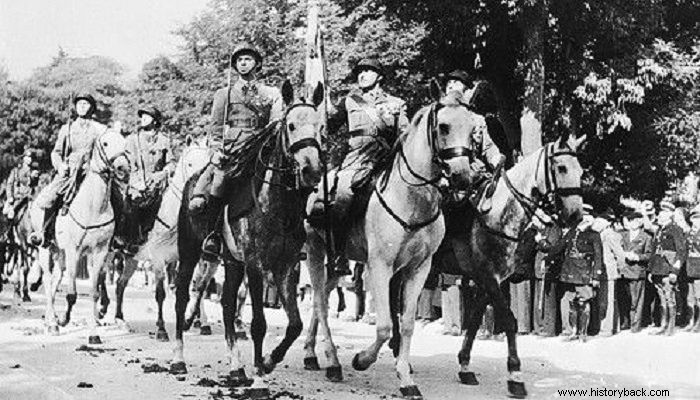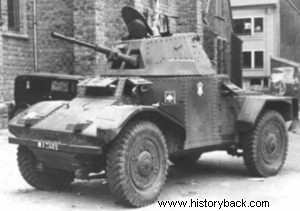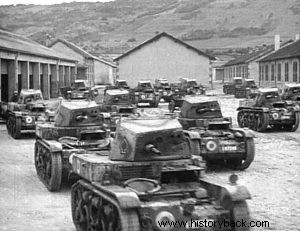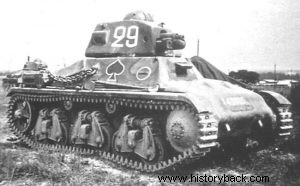
In 1940 the French army extended five Cavalry Divisions. Of these four were in the Ardennes sector when the Germans attacked on 10 May. The French 2nd Army of General Huntziger and the 9th Army of General Cora had been deployed in this sector. The first had the 2nd and 5th Light Cavalry Divisions (LMI), as they were officially called, and the second the 1st and 4th LMI.
The mission of the French cavalry was to deploy in the difficult terrain of the Ardennes region and hold the German first echelons until the two friendly armies were deployed on the designated ground covering the movement of friendly armies that would enter deep into Belgian territory. Their aim was to delay the Germans for 4 days.
On 10 May the four EMIs moved forward to fulfill their mission. The French command believed that the forces of the four EMIs were more than sufficient to hold the German first offensive echelons. No French general believed that the EMI would be facing a river of steel. Along with the 1st and 4th EMI, the 3rd Spachid Brigade (two regiments of Moroccan and Algerian cavalry) was active. This force moved without encountering enemies.
However, the 2nd and 5th EMIs in their movement literally ran into General Gunderian's XIX Panzer Corps (SSPA). The 2nd EMI, pressed by German tanks, retreated to the Semois River that afternoon amid waves of Belgian refugees. The 5th EMI found itself facing two German Panzer Divisions (Panzer Divisions) which of course it could not delay.
The next day it was now clear that the Germans were attempting a massive attack with masses of tanks in the otherwise "impassable" Ardennes. The 2nd and 5th EMIs broke up and abandoned the Semois line, sustaining heavy casualties. As a result of this, General Cora ordered the retreat of his cavalry. The French cavalry, however, fought, under the conditions, superbly, in a series of delaying maneuvers holding the Germans back for two days , while retreating, he also blew up the bridges on the Meuse River, the course of which was the main line of resistance of the French forces in the area.
However, on the evening of May 12, the motorcycle battalion of the 7th Infantry Division of the stormy General Erwin Rommel crossed, from an unguarded point, the river, creating a small and easily eliminated bridgehead. Due to poor coordination and poor cooperation between tanks and infantry, the French attack against the bridgehead launched on May 13 failed, also due to the Luftwaffe.
By the afternoon of the 13th the Germans had forded the river at the point and were channeling their forces south. But also in Montermey, the 6th and 8th BAs forcibly crossed the river, overturning the French resistance. The next day Guderian also destroyed the French position at Sedan. Already the gap on the French front stretched for many kilometers.
The French EMIs kept their cohesion, but weakened even more by the losses it was not possible to stop the disaster. The 5th EMI attempted to hold the second site, on the Bar River. It lasted until May 15th but then its location was broken. EMIs were ordered unhooked. Later the 2nd and 5th EMIs took part as a covering force in the unsuccessful British counter-attack on the Somme.
The second phase of the battle
After the division of the front and the encirclement of the northern allied armies, the new French commander-in-chief Veygan formed a front on the river Somme (west). The remnants of the EMI were regrouped and three new Light Motorized Divisions were formed with them (EMM – armored in essence). 4th EMI became 1st EMM, 5th EMI became 2nd EMM, 3rd EMI became 6th EMM, 4th EMI became 7th EMM and 5th EMI became 8th EMM.
However, the new divisions were not only complete and although they fought well, based on their capabilities in this second phase of the Battle of France, they could not withstand the impact of the German infantry. The 7th EMM (formerly the 5th EMI) particularly distinguished itself in the battles in the area of Retel on June 10 and 11. But all was in vain. After the devastating losses of the first phase of the battle the French army could not stand. The fight continued until June 25. Then it was all over.
Organization of EMI
Each EMI extended two brigades , one mounted with two regiments of cavalry – about 1,200 sabers in all – and one light motorized, with one motorized infantry regiment of two battalions (dragons) and a reconnaissance regiment with light tanks and armored vehicles. It had an artillery regiment of two divisions, a divisional 47mm anti-tank artillery. and 25mm anti-aircraft artillery. It also had an Engineering and Transmission company and services.
The cavalry brigade extended two regiments of four combat companies, a heavy weapons company and a command company, each. The regiment had 8 machine guns, 4 mortars of 60 hslt. and 4 anti-tank guns of 25 mm. The light motorized brigade had an anti-tank company with 12 25mm guns. the armored regiment and the dragoon regiment.
The armored regiment had two divisions , one with Panhard 178 vehicles and one with H-35, or AMR-35 light tanks. Each prefecture also had a motorcycle club. The regiment had a total of 34 chariots and armored vehicles. The dragoon regiment had two battalions (officially "principalities"), with a reconnaissance division, a rifle division and a heavy weapons division. The reconnaissance team had 5 AMR-33 chariots and two motorcycle ulamas. In total each dragoon battalion had, 12 machine guns, 26 machine guns, 24 grenade launchers, one 60 mm mortar. four 81 mm mortars; and four 25 mm anti-tank guns
The artillery regiment had a squadron of 75mm guns. and a 105mm howitzer In theory each EMI would be supported by an "organic" squadron of military cooperation aircraft. The 1st, 2nd and 5th EMIs were relatively endowed but soon, in the chaos that prevailed, all ceased to function. It is evident that from a formation with the equivalent of three infantry battalions and a light tank brigade the command should not have expected much. These light, literally, divisions found themselves facing hundreds of German panzers, and fatally succumbed.

Armored vehicle Panhard 178 French EMI.

Armatides AMP 35. Few of them were delivered to the EMI who relied mainly on the H-35.

Hotchkiss-H35 light battle tank.;Carried a 37mm short-barreled gun.
